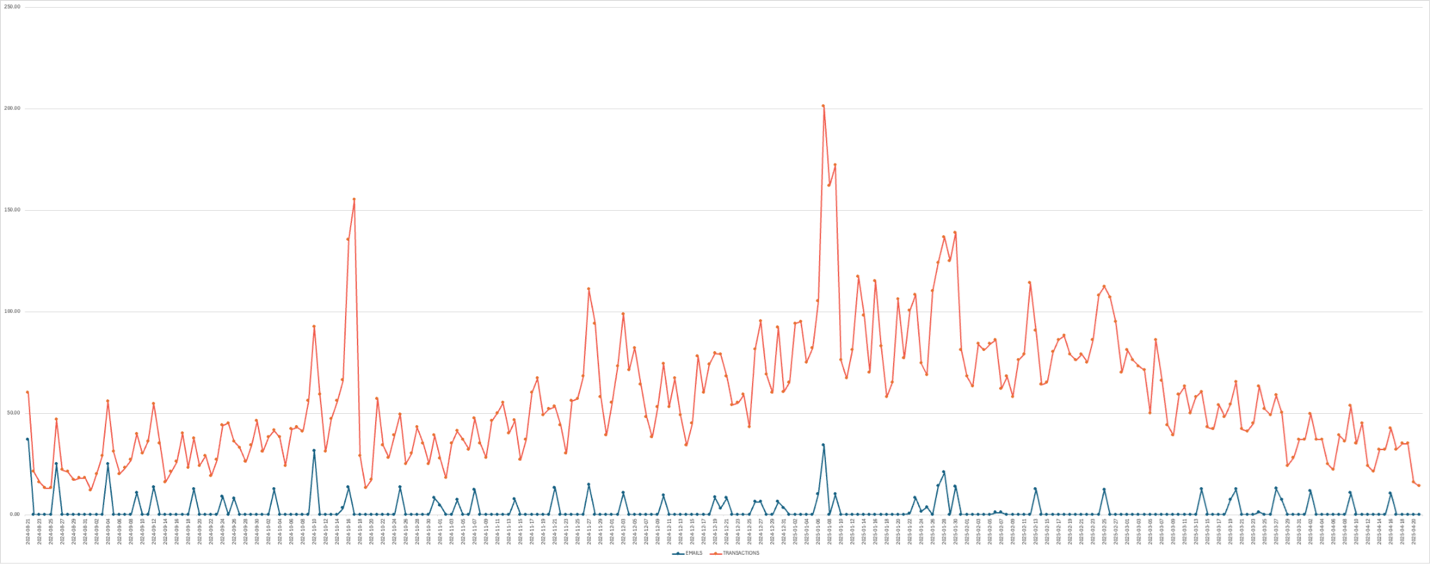Reframe What You Do: How to Showcase the Value of Email Marketing to Leadership
If you manage email campaigns, you’re doing more than sending messages—you’re managing relationships. This post will help you reframe your role by:
- Showing leadership how email drives real business outcomes
- Turning behavioral data into customer insight
- Structuring campaigns around the customer journey
- Naming campaigns with strategy in mind for better reporting and GA filtering
It’s time to stop underselling your impact. Let’s show them what email really does.
Rethinking the Role of Email
Email marketing often gets treated like the dependable workhorse of the marketing stack—reliable, cost-effective, and quietly successful. But because it runs so smoothly, it’s easy for leadership to undervalue its strategic importance.
Let’s flip that narrative.
Email marketing isn’t just a way to send messages. It’s a real-time relationship engine. It captures behavioral signals, powers retention strategies, and generates insights that should be fueling decision-making across your entire organization.
This post is your guide to reframing your role—so leadership sees you not as a campaign executor, but as a key player in your company’s growth strategy.
Talking Strategy with Leadership
Metrics like open rates, CTR, and bounce rates are valuable—but they’re not what your CFO or COO cares about. Elevate your language with phrases like:
- “We reduced churn by 12% through targeted re-engagement workflows.”
- “Email insights revealed a shift toward mobile-first behavior, guiding our next product sprint.”
- “Our top-performing lifecycle journeys are responsible for 30% of monthly recurring revenue.”
If your internal dashboard is framed around email-specific metrics, try building a parallel view that maps to business outcomes. That’s how you earn a seat at the strategy table.

A simple chart like this shows the correlation of email sends (in blue) with peaks in sales volume (in red).
Communicating the Value to Leadership
Many senior leaders still equate email performance with open rates and revenue per send (or revenue per email). Probably because we’ve trained them to think that way by emphasizing those KPIs in our reporting. And making a big deal when results exceed the typical benchmarks.
They might view it as a low-cost channel with decent ROI—but not as a core driver of customer relationships. Your challenge is to help them unlearn what they believe they know about email.
That’s where your storytelling skills come in.
It’s time to stop emphasizing reporting and start highlighting insights creation and deep data understanding. How? Start translating performance metrics into strategic impact. Did your last campaign win back inactive users? Did it trigger new product trials or reduce support requests? Did your email data uncover a shift in customer preferences or behavior?
Because it targets your customers, Email is often the first place these behaviors show up—and the best place to influence them. Your reporting should help stakeholders connect the dots between clicks and customer lifetime value.

Turning Metrics into Insight
I know what you’re thinking… must be complicated and requires new tools on a limited budget. Think again! You don’t need a massive tech stack to get powerful insights. If you manage email, you already sit on a goldmine of behavioral data.
- Opens and clicks tell you what’s resonating—down to timing, device, and messaging style.
- Unsubscribes can surface fatigue or friction points even before they affect churn.
- Audience engagement trends reveal not just what people do, but what they want.
And the best part? This data is real-time and first-party. In a world moving away from cookies and toward privacy-first strategies, that’s a serious competitive edge.
The next step is building a habit of sharing these insights—not just with your team, but across product, support, sales, and leadership.
For example, as I argued in a related post, A Customer Just Unsubscribed. What Are They Telling You? Are You Even Listening?, unsubscribes aren’t just a loss—they’re a message. Email marketers are often the first to see cracks in the customer relationship. CRM-minded teams treat that feedback as early-warning intelligence.
Naming Campaigns for Strategic Clarity
But how do you get more rich insights out of your email efforts? One good place to start is to think about your campaign naming. Your email campaign naming conventions aren’t just for internal housekeeping—they’re a powerful way to surface insights connecting marketing activity to business goals, and improve cross-platform reporting (by filtering GA4 or Adobe Analytics reports for example).
When you embed structured metadata directly into your email campaign names—such as audience segment, seasonality, product category, promotion type, or sequence order—you make it dramatically easier to:
- Group and compare like-for-like campaigns.
- Analyze performance trends across time periods or segments.
- Understand the context and objective of each message without needing to dig.
A well-labeled campaign like LOYALTY_Q3-2025_PROMO2_SURVEYFOLLOWUP tells you at a glance:
- It targets loyal customers.
- It ran in Q3 2025.
- It was the second promotional message.
- It followed a survey in the sequence.
Compare that to something generic like JulyNewsletter_v2—which offers no strategic context and minimal value in reporting.
Well-structured naming also unlocks sharper insights in your Google Analytics dashboards. When email UTM parameters include detailed campaign names, you can easily:
- Filter GA reports to isolate specific types of emails (e.g. REACTIVATION or HOLIDAY2025).
- Compare traffic, bounce rates, or conversions across lifecycle stages.
- Attribute outcomes more accurately to campaign objectives—not just time of send.
In short, consistent naming helps your data tell a smarter story—both in your ESP and in downstream tools like GA. It’s one of the fastest ways to increase the strategic credibility of your email program with leadership.

Adopting a Strategic Mindset: From Sender to Relationship Manager
Too often, email is thought of as tactical—something that gets scheduled after the “real” work is done.
But email is where customer relationships live and evolve. It’s where onboarding happens. Where upsells happen. Where retention is won—or lost.
If you start thinking in terms of lifecycle moments—first purchase, re-engagement, loyalty milestones—you’ll naturally move into a CRM mindset. You’ll stop asking, “What’s our next campaign?” and start asking, “Where is this customer in their journey, and what do they need from us now?”
That’s when email marketing becomes CRM in action.
It’s not an either/or between brand and performance. As I explored in Is Email Marketing a Relationship Marketing Channel or a High-Performance Sales Tool?, email can—and should—do both. Your ability to switch modes, depending on where the customer is in their journey, is exactly what makes email so powerful.
Framing Email Around the Customer Journey
Once you start speaking the language of leadership—connecting email performance to business outcomes—it’s important to show how your work aligns with the full customer journey.
Email is uniquely positioned to support every stage of that journey. From first touch to loyal advocate, it’s the one channel that consistently delivers personalized, permission-based communication over time. When leadership understands that email isn’t just a promotion tool but a relationship engine, your role becomes much harder to overlook.
Let’s break that journey down with a strategic lens:
- Awareness: Introduce your brand with welcome emails, lead magnets, or onboarding guides. These aren’t just entry points—they’re first impressions that shape long-term expectations.
- Consideration: Build trust with educational content, FAQs, product comparisons, or testimonials. Reinforce differentiation and relevance.
- Conversion: Use behavioral cues to trigger timely nudges, limited-time offers, or social proof that supports purchase decisions.
- Onboarding: Help new customers get value quickly through “getting started” sequences, usage tips, and milestone encouragement.
- Engagement: Keep the relationship alive with dynamic content, product updates, or interest-based messaging that adds continuous value.
- Renewal & Retention: Identify early warning signs of disengagement and respond with re-engagement campaigns, exclusive perks, or human outreach.
- Advocacy: Invite satisfied customers to refer others, leave reviews, or participate in brand communities.
When you structure your email program around this lifecycle mindset—and back it with structured naming and reporting—you transform email from a marketing function into a core piece of your customer strategy.
That’s exactly the kind of story leadership needs to hear.
Why Now Is the Moment to Reframe
Three big shifts are converging:
- Privacy expectations are rising. Brands need trusted, owned channels more than ever.
- Budgets are under pressure. Channels that deliver measurable ROI—and customer insight—become mission critical.
- AI is accelerating. But it’s only as good as the data and strategy behind it.
Email sits at the center of all three. It’s low-cost, high-insight, and fully controllable. If your organization doesn’t yet treat it like the strategic asset it is, this is the moment to change that.
Closing Thought
You don’t need to “learn CRM.” You’re already doing it—every time you build a lifecycle campaign, score your segments, or adjust your strategy based on data. Start with your next campaign report. Include lifecycle context and segment behavior—not just metrics. See how leadership responds.
This is your moment to stop thinking of yourself as “just” an email marketer. You are a CRM strategist. Now let the rest of the company see it too.
TL;DR
Email is often overlooked because it runs so well. But you know better.
By reframing your email program through a CRM lens, you position yourself not just as a campaign manager—but as a strategic partner. You now have the tools to:
- Translate metrics into meaningful business impact
- Align campaigns with customer lifecycle stages
- Use structured naming to unlock smarter reporting and GA insights
- Demonstrate your influence on retention, reactivation, and loyalty
Ready to elevate how your organization sees email? Start by changing the way you talk about it. Then show the numbers that leadership can’t ignore.

 How to resolve AdBlock issue?
How to resolve AdBlock issue? 
